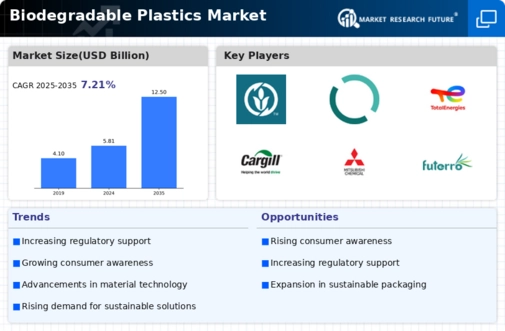Top Industry Leaders in the Biodegradable Plastics Market

Biodegradable Plastics Market
The global biodegradable plastics market is driven by rising environmental concerns and stricter regulations on traditional plastics, making biodegradable alternatives increasingly attractive. Let's delve into the competitive landscape, uncovering the strategies, market share factors, industry news, and recent developments shaping this dynamic market.
Strategies for Market Share:
Players adopt diverse strategies to navigate this competitive terrain:
-
Product Innovation: Developing new bioplastics with improved properties like faster biodegradation, wider compatibility with existing recycling infrastructure, and enhanced mechanical strength. -
Feedstock Diversification: Exploring alternative feedstocks like seaweed, cellulose, and food waste to reduce dependence on agricultural sources and enhance sustainability. -
Production Efficiency: Investing in advanced fermentation and polymerization technologies to improve production efficiency and reduce costs. -
Strategic Partnerships: Collaborating with research institutes, retailers, and waste management companies to accelerate market adoption and create closed-loop recycling systems. -
Consumer Education: Raising awareness about bioplastics and their benefits to address consumer concerns and drive market demand.
Market Share Factors:
Several factors influence a player's market share:
-
Product Portfolio: Offering a variety of bioplastics tailored to specific applications like packaging, agriculture, or textiles strengthens brand preference. -
Cost-competitiveness: Balancing bioplastics' environmental benefits with competitive pricing compared to traditional plastics is crucial for broader adoption. -
Biodegradation Performance: Offering bioplastics with faster and complete degradation in relevant environments like soil or compost facilities is essential. -
Sustainability Practices: Implementing eco-friendly production processes and using certified compostable materials attract environmentally conscious consumers and businesses. -
Regional Regulations: Stringent regulations on traditional plastics and supportive policies promoting bioplastics adoption in key regions like the EU and China influence market share.
Key Players:
- BASF (Germany)
- Mitsubishi Chemical Holding Corporation (Japan)
- Biome Bioplastics (UK)
- NatureWorks (US)
- Total Corbion (Netherlands)
- Novamont (Italy)
Recent Developments:
June 2023 saw BASF announce the official opening of a Biodegradation and Microplastic Center of Excellence at its site in Michigan to help regional customers achieve their sustainability and circularity goals. These will include understanding how well compostable materials break down, the degradability of new chemistries and gathering new insights into microplastics.
May 2023 witnessed TotalEnergies Corbion and Bluepha Co. Ltd signing an MoU on speeding up the use of PLA/PHA-based solutions in China. The purpose of this collaboration is to propel research on multiple high-performance biopolymer offerings by merging Luminy Polylactic Acid (PLA) technology from the former with Bluepha Polyhydroxyalkanoates (PHA).
In May 2023, TotalEnergies Corbion announced its partnership with Xiamen Changsu Industrial Pte Ltd. to develop the PLA sector. The market promotion and R&D development companies are focusing on BOPLA (biaxially oriented polylactic acid) as a new technology application.

